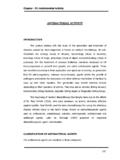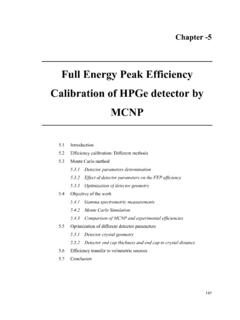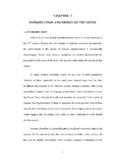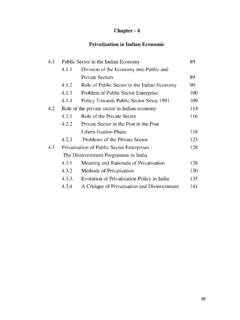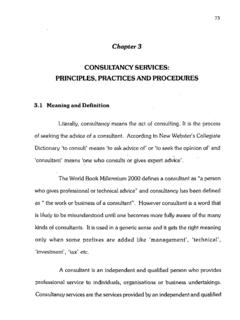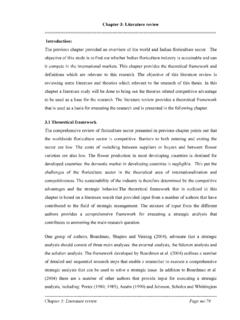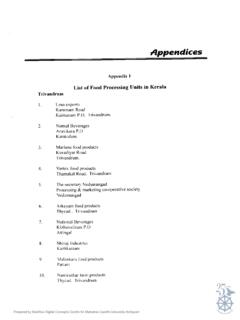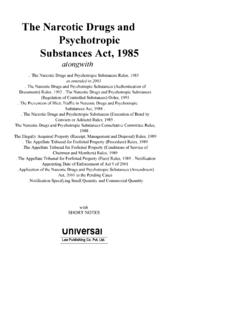Transcription of EN Series Steels - INFLIBNET
1 89 chapter -5EN Series SteelsSurface finish and surface hardness of the components play vitalrole in quality of products/components, in generalandfailureresistance,in of thefinishingprocessinvolvingsurfaceplast ic deformationthat introducecompressive residual stresses andthereby improve fatigue resistance is Burnishing . Even though theburnishingprocess iswidely employed,its process parameters werenotsystematically studiedtill dateandnotfullyestablishedfor variousimportantstructural parametersincludeforce,speed,feed, and number oftoolpasses. In the presentstudy,the data obtained fromsystematically conducted burnishingexperiments are correlatedwith theoretical design using Taguchimethodin case of EN Series Steels (EN 8, EN 24and EN31).
2 Thesurface characterizationemployed includesoptical microscopy, microhardnessandmagnitude ofresidual stress. The study revealed a one-to-one correlation between burnishing depth, increase in averagemicro hardness and magnitude of compressive residual stresses and apeak in all these three at intermittent extent of burnishing (either afterfirst or second pass) in all the three alloy of the characterizationof materials that was study in thepresent thesis pertained to alloy Steels . Alloy Steels are defined as asteels alloyed with variety of elements in total amounts ranging from901% to 50% by weight to improve their mechanical properties.
3 Theseare classified as low alloy and high alloy Steels . The Steels with alloycontains lower than 4-5% are considered as low alloy Steels whilethose higher than 8% alloying elements are called high alloy commonly employed elements in these Steels include Mn(mostcommon), Ni,Cr,Mo,V,Si and Boron, less commonly used alloyingelements include Al,Co,Cu,Ce,Nb,Ti,W,Sn andZr. These steelsfind wide range of applications such as turbine blades in jet engines,space crafts and components for nuclear reactorsand also findapplications in electrical motors and of thecommonly used alloy Steels and their equivalent grades are given The standard chemical composition of EN Series Steels aregiven in table :Alloydesignations of select Engineering MaterialsEquivalent GradesInternalStandardBSDINISENSAE/AISIE N18530A4037Cr440Cr1EN185140EN24817M4034 CrNiMo640 NiCr4Mo3EN244340EN19C709M40-40Cr4Mo3EN19 C4140,4142EN19709M4042Cr4Mo240Cr4Mo3EN19 4140.
4 Chemical composition of EN Series steelsCMnSiSPCrNiMoEN order to establish the clear picture of burnishing process, aseries of experiments were conducted on metals which find wide rangeof industrial applications, such asEN 8, EN 24 and EN 31alloy theseexperiments, the work pieces were burnished after turning onlathe,keepingthe roller burnishing tool fixed inthelathe tooldynamometer. The dynamometer isemployed to measure three force92components, along x, y and z directions(force in z direction is takenas burnishingforce). work piece materials are EN 8,EN 24 and EN 31 (alloysteels) andthe nominal composition of the experimental materials isgiven in the three alloy Steels are in quenched(hardened) and : Chemical composition of the experimental materialsMaterialComposition, in Wt.
5 %CSiMnCrNiSPEN Results and roughnessThe values of surface finish, a directmeasurement of surfaceroughness before and after burnishing as a function of burnishingspeed and burnishing feedare givenin , optimal forces for EN 8, EN24 and EN31 are 210N, 170 Nand200N respectively. The feed for all materials is taken as these data (data in )optimal speed and feed values which result in highest increase insurface finish are determined andthesame are given in in the extent of improvement in the surface finish for ENseries Steels obtained in the present investigation (for that matter, forany other material) depends uponmicrostructural features and thelevels of hardness and/or strength (in the present case microhardnessvalues).
6 : Comparison of surface finish values before and afterburnishing for a 30 mm diameter work piece ofalloysteelsasafunction ofburnishing (m/min)Surfacefinish beforeburnishingRa( m)Surface finish afterburnishing Ra( m)% increase insurface finishFirstpassSecondpassThirdpassFirstp assSecondpassThirdpassEN of surface finish values before and afterburnishing for a 30 mm diameter work piece of alloy Steels as afunction of burnishing beforeburnishingRa( m)Surface finish afterburnishing Ra( m)% increase insurface finish22m/min34m/min51m/min22m/min34m/mi n51m/minEN : Variation of burnishing speed with % increasein surface finishfor different passes in (a) EN 8 (b) EN 24 and(c)EN 31 alloy 1st pass 2nd pass 3rd passSpeed, m/min% increase in surface finish(b) EN 2410203040500102030405060708090100 1st pass 2nd pass 3rd passSpeed, m/min% increase in surface finish(c) EN 311020304050102030405060708090100 1st pass 2nd pass 3rd passSpeed, m/min% increase in surface finish(a) EN.
7 Variation of burnishing feed with % increase in surface finishat different speeds in (a) EN 8 (b) EN 24 and(c)EN 31 alloy 22 m/min 34 m/min 51 m/min(a) EN 8 Feed, mm/rev% increase in surface 22 m/min 34 m/min 51 m/min(b) EN 24 Feed, mm/rev% increase in surface 22 m/min 34 m/min 51 m/min(c) EN 31 Feed, mm/rev% increase in surface valuesof burnishing parametersfor the alloysteels, EN8, EN24 and (m/min)No ofpassesForce(N)Feed(mm/rev)Ra( m)EN the typicalset ofoptical micrographsobtained from EN8, En 24 and EN31 alloy steelsin the unburnished(Fig. ) and burnished(Fig. for first pass, Fig. for secondpass, Fig. for third pass) conditions.
8 The optical micrographs(corresponding to surfaces from periphery to inner cross section of thecylindrical specimens)show similar structure with varied burnisheddepths for different burnishing conditionsin all the three alloy figures clearly show a distinct variation in the thickness ofburnishing affectedzone with each of the burnished in depth of these zones ismeasured from micrographs andthesame are given clearly revealthat highest burnishing depth occurs at 1stpass in EN 8 and EN 31while the same occurs at 2ndpass in EN 24 alloy steel . It should benoted here that the highest depth of burnishing presumably providesmaximumeffectiveness in surface actual values ofburnishing layer thickness are obtained experimentally.
9 The variationof burnishing layer thickness which is different for different EN series98steels is a function of many microstructural and surface conditiondependent principal reasons for such variationobserved in the present study was not investigated in the presentthesis as this requires detailed microstructural analysis involvingtransmission electron microscopy.(a)(b)(c)(d)Fig. : Optical micrographsof EN 8 showing the depth of burnishingin(a) Unburnished (b)Burnished 1stpass (c)Burnished 2ndpass(d)Burnished 3rdpass conditions99(a)(b)(c)(d)Fig. : Optical micrographsof EN 24 showing the depth ofburnishingin(a) Unburnished (b)Burnished 1stpass (c)Burnished 2ndpass (d)Burnished 3rdpass conditions100(a)(b)(c)(d)Fig.
10 : Optical micrographsof EN 31 showing the depth ofburnishingin (a) Unburnished (b) Burnished 1stpass (c) Burnished 2ndpass(d) burnished 3rdpass : Variation of burnishinglayer thicknessin theburnishing zone for three alloy ProcessBBB1B2B3EN 8 Burnishing layer 24 Burnishing layer 31 Burnishing layer [BB Before burnishing, B1 Burnished-1stpass, B2 Burnished-2ndpass andB3 Burnished-3rdpass] specimens polished to obtain microstructure were further usedto determine the variation in microhardness as a function of distancefrom the surface. The microhardness values are found to be almostsimilar with no systematic variation with the burnishing , an average value of microhardness is taken as arepresentative value for each of the experimental condition such.
